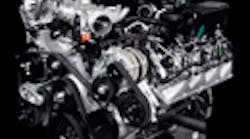Ford Motor Co.’s all-new 6.7-liter Power Stroke V-8 turbocharged diesel engine should be available for purchase starting in the spring of 2010, though the manufacturer doesn’t plan to reveal the surcharge for its emission control aftertreatment package until the end of this year.
Read more about the Ford Super Duty truck line
In a conference call with reporters, Brian Rathsburg, Ford’s marketing manager for its Super Duty truck line, added that warranty coverage information for the new diesel won’t be available until the beginning of 2010.
Rathsburg also noted the aftertreatment package for Ford’s new diesel engine combines a diesel particulate filter (DPF) for capturing soot particles with a selective catalytic reduction (SCR) system to reduce oxides of nitrogen (NOx) into a single sequential unit.
Adam Gryglak, Ford’s lead diesel engineer, added that new designs combined with new materials should boost the efficiency and performance of the new Power Stroke in comparison with the previous Power Stroke models built for Ford by Navistar. The company did not release potential horsepower or torque ratings.
For starters, Gryglak said Ford’s V-8 diesel is built using a compacted graphite iron (CGI) engine block with aluminum cylinder heads, helping the new Power Stroke shed 160 lbs. compared to its previous incarnation. A new “inboard exhaust” architecture also reduces the weight of the engine while reducing overall exhaust system volume, leading to better throttle response. The exhaust system design also reduces surface area to minimize heat transfer to the engine compartment – thus lowering the strain on the cooling system – while improving noise, vibration and harshness (NVH) characteristics.
Gryglak noted that the engine’s single-sequential turbocharger, built by Honeywell, is center-mounted on a pedestal low in the back of the engine’s “valley” to reduce NVH as well. He said the turbocharger’s unique design allows it to deliver the benefits of a twin-turbocharger system in a smaller, more efficient package – combining the benefits of a small turbocharger (faster response) and a large turbocharger (ability to compress and force more air into the engine for more power) in one package.
The engine’s high-pressure fuel system, built by Bosch, injects fuel at up to 30,000 psi; delivering from one to five injection events per cylinder per cycle using eight-hole piezo injectors to spray fuel into the piston bowl. Again, the benefits of this direct-injection system allows for reduced NVH, along with optimum power and fuel efficiency, noted Scott DeRaad, Ford’s NVH engineer
Ed WasczenkoNormal0falsefalsefalseEN-USX-NONEX-NONEMicrosoftInternetExplorer4, Ford’s durability engineer, pointed out that the OEM made sure this new diesel successfully met industry standard 250,000 mi. durability requirements, going so far as to operate its test models for 30 days straight at maximum speed and simulating 2,600 below-zero engine starts; roughly 10 years worth of customer usage in arctic conditions.
In all, Gryglak said Ford has applied for 111 patents related to the company’s new diesel engine and supporting powertrain components.
Rathsburg noted in summation that Ford’s new V-8 diesel will debut in the 2011 F-Series Super Duty truck line and will be biodiesel compatible up to a B20 blend; 20% biodiesel mixed with 80% regular petroleum diesel.



